- GreenMatch
- Blog
- Is Recycling Good for the Environment? Stats, Trends And Facts
The Top Impact of Recycling By Types of Waste


Recycling emerged as a fundamental component of modern waste management practices, offering a pathway to mitigate the environmental footprint associated with the disposal of municipal solid waste (MSW) and industrial by-products. The environmental benefits of recycling extend across multiple dimensions, including conservation of natural resources, energy savings, reduction of greenhouse gas emissions, and minimising the volume of waste destined for landfills.
In 2018, the recycling, composting, combustion with energy recovery, and landfilling of MSW saved over 193 million metric tons of carbon dioxide equivalent (MMTCO2E), which is comparable to the emissions that could be reduced by taking almost 42 million cars off the road for a year.
This practice has been advocated for decades as a way to reduce the environmental footprint of human consumption.
In addition, this not only benefits the environment but also has a positive impact on the economy. It creates jobs in the recycling and manufacturing industries. For instance, recycling 10,000 tons of waste creates 36 jobs, significantly more than landfilling or incinerating the same amount.
But how beneficial is recycling truly for the environment? To answer this question, we explore various aspects, including the type of waste and their statistics, trends, and facts about recycling and its environmental impact.
- What do we mean by recycling exactly?
- The three Rs of waste management
- Key statistics and trends
- Food recycling statistics and facts
- Paper recycling statistics and facts
- Plastics recycling statistics and facts
- Glass recycling statistics and facts
- E-Waste recycling statistics and facts
- Aluminium recycling statistics and facts
- Textile recycling statistics and facts
- Metal recycling statistics and facts
- Which countries are the best at recycling?
- Environmental impact of recycling
- Challenges and limitations
- Future directions
- Frequently asked questions
What do we mean by recycling exactly?
Recycling involves collecting and processing materials that would otherwise be discarded as trash and transforming them into new products. This seemingly simple concept encompasses many activities and benefits, touching on community development, economic growth, and, most importantly, environmental protection.
The process is a critical component of waste reduction strategies and adheres to the "Reduce, Reuse, and Recycle" waste hierarchy.
The process can be divided into three main steps: collection and processing, manufacturing, and purchasing recycled products. These materials are then sorted, cleaned, and processed into raw materials that manufacturers can use to produce new products. Finally, the cycle is completed when consumers purchase products made from recycled materials, thereby supporting the recycling loop.
Benefits of recycling
Recycling offers numerous benefits to the environment, economy, and society:
- Environmental Conservation: To conserve natural resources like timber, water, and minerals and reduce the need to extract and process raw materials. Similarly, recycling paper saves trees and water, with a 40% energy saving compared to producing new paper from wood pulp. This, in turn, conserves energy and reduces greenhouse gas emissions, contributing to the fight against climate change.
- Energy Savings: Manufacturing products from recycled materials requires significantly less energy than producing them from virgin materials. For instance, recycling aluminium saves 95% of the energy needed to make the same amount of aluminium from its raw bauxite ore.
- Economic Growth: Recycling creates jobs in the manufacturing industries. It has been reported that recycling 10,000 tons of waste creates 36 jobs, significantly more than the number of jobs created by landfilling or incinerating the same amount of waste.
- Reduction of Waste and Pollution: By diverting waste from landfills and incinerators, recycling helps reduce pollution and the harmful effects of waste disposal on the environment.
Climate impact and resource conservation
- It can significantly cut carbon dioxide emissions by an estimated 700 million tonnes annually. This reduction is due to the decreased need for new natural resources and fossil fuels, often used to produce new materials like plastics.
- For every tonne of paper recycled, 17 trees can be saved, and the water used in manufacturing is cut by 50%.
- It can potentially reduce carbon emissions by the equivalent of 10.4-11.2Gt of carbon, comparable to Japan's annual carbon dioxide emissions.
- Composting food waste can reduce carbon emissions by 14% compared to dumping it into landfill.
Waste management and recycling rates
- The United States has a municipal solid waste (MSW) recycling rate of around 35%, with significant room for improvement.
- Recycling rates for all textiles are around 15%, and 95% of textiles have the potential to be recycled or reused.
- The recycling rate for cardboard in the US reached nearly 97% in 2019.
- Only 17.4% of electronic waste is collected and recycled globally despite containing valuable materials like gold, silver, and platinum.
The three Rs of waste management
The waste management concept has evolved significantly over the years, leading to adopting the "Three Rs" principle: Reduce, Reuse, and Recycle. This hierarchy is crucial for minimising the environmental impact of waste.
The prioritisation of reduction and reuse over recycling is based on their incredible environmental benefits. Reducing consumption minimises the demand for new products and the consequent environmental impact of their production. Reuse, on the other hand, directly extends the lifecycle of products and materials, further reducing the need for new resources.
| Waste Management Strategy | Environmental Benefits | Challenges |
|---|---|---|
| Reduce | - Minimises resource and energy use- Decreases production and transportation impacts | - Requires changes in consumption habits- May impact economic growth |
| Reuse | - Extends product lifecycles- Conserves resources and energy | - May require repair or modification- Limited applicability for some products |
| Recycle | - Reduces demand for raw materials- Prevents pollution and waste | - Can be expensive- May result in lower-quality materials |
Key statistics and trends
Look at some critical components of sustainable waste management and environmental conservation. The rates vary significantly across different materials due to factors such as the availability of recycling facilities, market demand for recycled materials, and public awareness.
Here are the current recycling rates for key materials:
- In the UK, the recycling rate of household waste has gradually increased over the years, reaching 45.2%.
- The EU’s municipal waste recycling rate has been improving, reaching 49%, intending to recycle at least 60% by 2030.
- Recycling rates vary significantly by country, with Slovenia and Germany leading with rates above 50%, while other countries recycle less than 20% of their municipal waste.
- Plastic recycling rates in the US are low, with only 5-6% of plastic waste being recycled.
- Aluminium and steel are highly recyclable metals, with significant energy savings and CO2 emission reductions when recycled.
- Metal recycling in the UK is also significant, with steel being the most recycled metal, followed by aluminium and copper.
- Cross-contamination of recyclables with non-recyclable items is a common issue that hinders effectiveness.
Food recycling statistics and facts
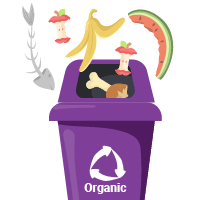
Food waste recycling, including composting, is gaining traction but needs to be more utilised. Reducing food waste and improving composting facilities can significantly impact the rates.
Here are some key statistics and facts about food waste:
- Globally, approximately 2.5 billion tons of food are wasted yearly, with the United States leading in food wastage, discarding nearly 60 million tons annually.
- Roughly one-third of the food produced for human consumption every year, approximately 1.3 billion tons, is wasted or lost.
- If food waste were a country, it would be the third-highest emitter of greenhouse gases behind the USA and China.
- The food currently wasted in Europe could feed 200 million people, 300 million in Latin America, and 300 million in Africa.
- The UK produces the highest amount of food waste in Europe, with an estimated 14 million tonnes each year.
- Food waste contributes heavily to global warming, releasing methane gas 25 times more harmful than carbon dioxide.
- Every tonne of food waste ending in landfills produces approximately 4.4 tonnes of greenhouse gases.
- The water used to produce the wasted food could be used by 9 billion people at around 200 litres per person daily.
- 8.4 million people in the UK struggle to eat, and 1.5 million adults in London and 400,000 children experience hunger.
- 65% of UK adults admit to buying too much food that is thrown away.
- A survey by Respect Food found that 63% of people don’t know the difference between “use by” and “best before” dates, leading to unnecessary waste.
- 40% of food waste in the UK hospitality industry is carbohydrates.
- Recycling and composting municipal solid waste (MSW) have saved over 193 million metric tons of carbon dioxide equivalent, highlighting the potential environmental benefits of increasing food recycling rates.
Paper recycling statistics and facts
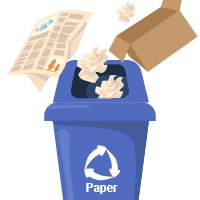
Paper recycling is crucial to sustainable waste management, offering environmental and economic benefits. Paper and paperboard materials constituted the most significant component of MSW, accounting for 43.1% of total MSW generation. Moreover, recycling paper helps mitigate methane emissions from landfills, as decomposing paper is a significant source of landfill methane, a potent greenhouse gas.
Let's delve into the latest statistics, facts, and trends in paper recycling, providing a comprehensive overview of its significance and impact on the environment.
- The European paper value chain achieved a rate of 70.5% in 2022, with a commitment to reach a 76% rate by 2030.
- The global average rate stood at 59.9% the same year, showcasing Europe's leadership in this domain.
- Recovered paper is a primary raw material for the paper industry, with over 70% of the fibre used in the UK paper and board industry coming from recycled paper.
- Recycling one ton of paper can save 17 trees, 7,000 gallons of water, and 3.3 cubic yards of landfill space.
- Paper mills can be significant polluters; recycling paper reduces air pollution by up to 74%.
- In the United States, the rate of paper and paperboard was nearly 68% in 2022, indicating a strong recycling culture.
- Recycled paper produces 39% less solid waste.
- Notably, corrugated boxes had a recycling rate of 96.5%, while paper containers and packaging, excluding corrugated boxes, had a rate of 20.8%.
- The total generation of paper and paperboard in MSW was 67.4 million tons, with approximately 46 million tons recycled, translating to a rate of 68.2%.
- The paper recycling market was valued at £5.64 billion in 2023 and is expected to grow at a CAGR of 5.7% from 2024 to 2034, reaching a projected market value of £10.40 billion by the end of the forecast period.
Plastics recycling statistics and facts
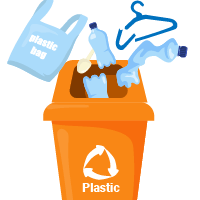
Plastic use is a critical issue that requires urgent attention to reduce the manufacturing of unnecessary single-use plastic, which threatens the environment. The rate is alarmingly low compared to how plastic is used, with only 9% of plastic waste being recycled. The rest is incinerated, landfilled, or leaks into the environment, contributing to plastic pollution.
Let’s look at the current state of plastic recycling by highlighting the most significant stats, facts, trends and economic benefits associated with efforts.
- Globally, only 9% of plastic waste is recycled, with 19% incinerated and 50% ending up in landfills or the environment.
- In the UK, 86% of plastic packaging is recovered, and 75% of PET drink bottles are recycled.
- Not all plastic is recyclable, and the recyclability of plastic depends on both market demand and local government policies. For example, plastic bags and straws are generally not recyclable, while certain plastics like PET (29.1%) and HDPE (29.3%) are more commonly recycled.
- The quality of plastic degrades with each recycling process, which can limit the number of times plastic can be recycled.
- Recycled plastic can make various products, including clothing, bin liners, carrier bags, and more.
- Recycling creates more jobs compared to landfilling or incinerating waste.
- A single ton of recycled plastic saves approximately 23 cubic meters of landfill space and 3,114 litres of oil.
- Most domestic plastic consumers in the UK recycle less than half of their plastic waste.
- If all plastic were recycled, it could save 30 - 150 million tons of CO2 annually, equivalent to closing between 8 and 42 coal-fired power plants.
- Plastic consumption grows by around 4% each year in Western Europe.
- Dirty plastics, or those with food residues, cannot be recycled and must be cleaned before being placed in recycling bins.
Glass recycling statistics and facts
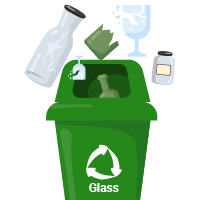
Glass recycling is critical to environmental sustainability, offering a way to conserve natural resources, reduce energy consumption, and minimise pollution. The glass industry continues to work towards increasing rates and improving the quality of recycled glass.
Here are some key statistics and facts about glass recycling:
- The glass recycling industry is a significant economic player, with a global market value estimated at approximately £1.28 billion.
- Recycling glass not only conserves natural resources but also saves energy. For instance, recycling a single glass jar can save enough energy to power a 100-watt light bulb for four hours. Moreover, the energy cost drops by 2-3% for every 10% of the cullet (recycled glass) used in manufacturing.
- The UK glass sector boasts a rate of 74.2%, one of the highest for any packaging material.
- Recycling glass reduces CO2 emissions and energy use, with every tonne of glass re-melted saving 580kg of carbon dioxide emissions.
- The UK recycles around 50% of its glass, but some countries like Finland and Switzerland recycle more than 90%.
- Recycled glass (cullet) requires a lower heating temperature than new glass, saving up to 40% energy.
- A glass container can go from a recycling bin to a supermarket shelf in as little as 30 days.
- The container and fibreglass industries purchase 3.35 million tons of recycled glass annually for new containers and products.
- Recycled glass is used to manufacture new bottles, jars, windows, fibreglass, and industrial glass beads.
- Not all glass is recyclable together; for example, container glass must be separated from window or ovenware glass.
- Recycling 1,000 tons of glass creates over eight jobs.
- Glass recycling significantly reduces air pollution by 20% and water pollution by 50%.
- Using recycled glass cullet saves raw materials like sand, soda ash, and limestone.
- While glass is 100% recyclable and can be recycled endlessly without losing quality, rates vary significantly across regions.
- Europe boasts high glass rates, up to 90%, while the United States recycles about 33.9% of its glass. Australia manages to recycle about 56% of its glass usage.
E-Waste recycling statistics and facts
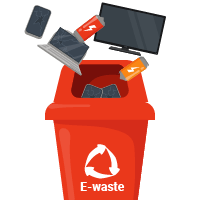
Electronic waste, or e-waste, represents a significant environmental challenge globally. This is because it is one of the fastest-growing waste streams. Despite containing valuable metals and components, only a tiny fraction of electronic waste is recycled. The complexity of e-waste and the need for specialised processes contribute to lower recycling rates.
Here are some key statistics and facts about e-waste recycling:
- Over 50 million metric tons of e-waste are generated yearly, averaging about seven kilograms per capita.
- In 2019, the world produced approximately 53.6 million tonnes of e-waste, but only 17.4% of this was documented to be collected and properly recycled.
- By the end of 2022, 420.3 million metric tonnes of e-waste had been produced globally.
- The global e-waste generation grows annually by about 3 to 4%, attributed to higher consumption rates of electronics, increasing by 3% annually, shorter product lifecycles, and limited repair options.
- E-waste accounts for 70% of toxic waste in US landfills despite making up only 2% of the trash.
- Recycling just one million used cell phones can recover as much as 772 lbs of silver, 35,000 lbs of copper, 75 lbs of gold, and 33 lbs of palladium.
- The United Nations Environment Programme (UNEP) estimated that electronic waste worth nearly GBP 14.5 billion is illegally traded or dumped yearly.
- 14% of consumers throw electronics away with other garbage, contributing to the improper disposal of e-waste.
- Norway and the UK are among the top countries in terms of e-waste generated per capita, with Norway producing the most e-waste at 26 kg per person and the UK ranking second.
- Northern Europe has the highest documented e-waste collection and proper rate, at 59%.
- Improper e-waste recycling is responsible for 25% of data breaches, highlighting the importance of proper data destruction in addition to environmental concerns.
- E-waste contains hazardous components such as mercury, lead, cadmium, and polybrominated flame retardants, which can contaminate groundwater and pose serious health risks to humans if not properly recycled.
- The global e-waste management market was valued at £39,375.2 million in 2020 and is projected to almost triple to £113,617.3 million by 2028.
Aluminium recycling statistics and facts
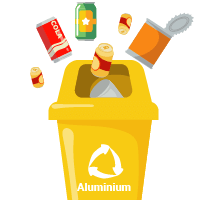
Aluminium recycling is a critical component of global sustainability efforts. Aluminium requires nearly twice as much energy as glass to manufacture, with an estimated 1.09 kilowatt-hours of energy needed to manufacture a glass bottle compared to nearly twice as much for an aluminium can.
Here are some key statistics and facts about aluminium recycling:
- The global recycling efficiency rate for aluminium is 76%.
- Recycling aluminium saves 95% of the energy required to produce the same aluminium from its virgin source, bauxite.
- Aluminium takes a very long time to decompose, with estimates ranging from 80 to 100 years and potentially much more prolonged in landfills.
- Aluminium can be recycled an unlimited number of times without degradation in quality.
- Over 207,000 tonnes of aluminium packaging are put on the market in the UK annually, with a recycling rate of 56%.
- Aluminium cans account for less than 1% of the US waste stream due to high recycling rates.
- Recycling aluminium saves energy and resources and offers economic benefits, as people can earn money by recycling aluminium.
- If all aluminium cans were recycled, approximately 14 million fewer dustbins would be emptied into landfill sites each year.
- Aluminium forms around 8% of the Earth's crust and is used in numerous industries.
- A recycled aluminium can could be back on the shelf as a new can in just 60 days. Aluminium cans are part of a closed-loop recycling process, meaning they can be repeatedly recycled into new cans.
Textile recycling statistics and facts

Textile recycling is essential to a sustainable future, offering significant environmental benefits. The textile industry substantially contributes to global waste, with alarming statistics highlighting the urgent need for recycling and sustainable practices. The diversity of materials and the need for recycling infrastructure are significant obstacles.
Here are some key facts and figures:
- Over 92 million tonnes of textile waste are produced each year globally.
- The apparel industry's emissions are projected to increase by 50% by 2030.
- In 2018, the United States generated 17 million tons of textile waste, constituting 5.8 per cent of total municipal solid waste (MSW).
- Despite the vast amount of textile waste, the recycling rate for all textiles was only 14.7 per cent, with 2.5 million tons recycled.
- The number of times a garment is worn has decreased by around 36% in 15 years.
- In the UK, around 360,000 tonnes of clothes are thrown away yearly.
- Some clothing materials can take up to 200 years to decompose.
- Approximately 70% of the world wears secondhand clothing.
- Many items are worn only seven to ten times before being discarded.
- It takes 20,000 litres of water to produce one kilogram of cotton.
- Nearly 10% of microplastics in the ocean come from textiles
- Around £395 billion is lost yearly due to under-wearing and failing to recycle clothes.
- Nearly 100% of donated textiles are recyclable, with many being turned into new products.
Metal recycling statistics and facts
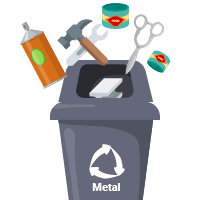
Recycling metals is both economically and environmentally beneficial. It uses less energy than producing metals from raw materials, saving costs and reducing energy consumption. Metal recycling is a critical component of the circular economy, contributing to environmental sustainability and resource conservation.
Here are some key statistics and facts about metal recycling:
- Using recycled steel to make new steel reduces air pollution by 86%, water use by 40%, and water pollution by 76%.
- Metals recycling saves up to 20 times the energy needed than extracting those metals.
- Every year, around 400 million tonnes of scrap metal are recycled worldwide.
- The global ferrous metal recycling industry is worth approximately £5 billion, while non-ferrous metal recycling is estimated to be worth almost £71 billion.
- The United States recycles 150 million metric tons of scrap metal each year.
- EU countries recycle 94 million tonnes of scrap metal, saving around 200 million tonnes of CO2 emissions annually.
- Steel recycling involves collecting, separating, compacting, shredding, heating, refining, and solidifying.
- Almost 69% of all steel is recycled in North America yearly, more than paper, aluminium, plastic, and glass combined.
- Recycling copper instead of extracting it from mined copper ore reduces CO2 emissions by 65%.
- For every ton of steel recycled, 2,500 pounds of iron ore, 1,400 pounds of coal, and 120 pounds of limestone are conserved.
- The metal recycling industry faces challenges, such as better policy frameworks to reward environmental benefits and ensure a well-functioning market.
Which countries are the best at recycling?
The global recycling landscape is diverse, with some countries achieving remarkable success in their recycling efforts. According to recent data, countries like Germany, Austria, South Korea, and Slovenia stand out for their high municipal solid waste recycling rates.
These countries have set the standard for recycling, combining government policy, technology, and public participation to achieve impressive results.
Germany, for instance, has been a consistent leader in recycling, with a rate of 48%. Slovenia and Germany had the highest MSW recycling rates among OECD countries, at 59% and 56%, respectively. South Korea leads globally with a recycling rate of 67.1%.
These countries have developed efficient waste management systems that include recycling as a critical component. For instance, Austria and Belgium have high incineration rates, with energy recovery at 38.9% and 42.3%, respectively, complementing their efforts. Similarly, countries like Sweden and Switzerland have high rates of incineration with energy recovery, which are 52.6% and 47%, respectively, indicating a strong emphasis on waste-to-energy practices. The global waste recycling services market was valued at an estimated £44.3 billion in 2022, with expectations for growth in the coming years. This growth is driven by increasing awareness of the environmental impacts of waste, advancements in technologies, and the economic benefits of recycling.
Top five recycling countries as of 2025
| Country | Recycling Rate (%) |
|---|---|
| South Korea | 67.1 |
| Slovenia | >60 |
| Samoa | 57.6 |
| Benin | 56.9 |
| Germany | 56 |
The five lowest recycling countries
The countries with the worst recycling rates face significant environmental and economic challenges. It should be noted that the recycling rates can vary significantly from year to year and are influenced by various factors, including policy changes, technological advancements, and economic conditions.
| Country | % Recycling | % Landfill | Economic Strategy to Improve Recycling |
|---|---|---|---|
| Chile | <1% | 70% | Circular economy strategy by 2040 |
| Mexico | 5% | 65% | Development of infrastructure and overconsumption |
| Turkey | 12% | 86.4% | Increased pressure to reduce waste imports |
| Greece | 16% | 77.7% | Implementation of Extended Producer Responsibility (EPR) schemes |
| Israel | 19% | 81% | £0.9 billion investment for improvement by 2030 |
Environmental impact of recycling
Recycling offers a viable solution to many environmental problems associated with waste disposal. It conserves natural resources, reduces pollution, saves energy, and provides economic benefits. However, for it to have a more significant impact, it needs to be part of an integrated approach that includes reducing consumption and reusing materials.
However, while recycling has numerous environmental benefits, it has its drawbacks.
What is so bad about recycling for the environment?
Despite its positive image, recycling can have negative environmental impacts. It is not a panacea for waste management issues and carries its own set of environmental drawbacks. Collecting, transporting, and processing recyclable materials consumes energy and generates carbon emissions. For instance, recycling operations involve using vehicles for collection and transportation to processing facilities, contributing to fossil fuel consumption and CO2 emissions.
Let's look at some of these drawbacks, which include:
- Pollution: The recycling process can produce pollutants. For example, breaking down waste materials can release toxins and impurities into the air, soil, or water.
- Energy Consumption: Recycling requires energy, often from fossil fuels, which can contribute to air pollution and greenhouse gas emissions.
- Inefficiency: The recycling process can sometimes be less effective than expected. For instance, the demand for certain materials, like aluminium, may outpace the supply that it can provide, necessitating the continued extraction of raw materials.
- Mismanagement: Improper handling of recycling operations can lead to environmental degradation, such as when companies abandon dumpsites
- Recycling plastic consumes less energy than producing new, virgin polymers and can save significant amounts of CO2 yearly.
- If all plastic were recycled, it could save 30 - 150 million tons of CO2 annually, equivalent to closing between 8 and 42 coal-fired power plants.
What is the impact?
The impact can be viewed from different perspectives:
Total impact per year
Recycling has a significant positive impact on the environment and economy annually. In the United States alone, recycling and reuse activities account for 681,000 jobs, £28.5 billion in wages, and £4.1 billion in tax revenues. Moreover, the recycling of municipal solid waste (MSW) saves over 193 million metric tons of carbon dioxide equivalent annually, highlighting its role in mitigating climate change.
Impact per day
Daily, recycling conserves energy and reduces greenhouse gas emissions. For example, recycling ten plastic bottles saves enough energy to power a laptop for over 25 hours. This daily energy conservation contributes to reducing dependence on fossil fuels and helps combat climate change.
Impact per usage
The impact can also be measured per usage or recycled item. Recycling one ton of paper saves 3.3 cubic yards of landfill space, and recycling a single aluminium can save enough energy to power a television for 3 hours. These examples illustrate the tangible benefits of recycling per item, demonstrating how individual actions can collectively lead to significant environmental benefits.
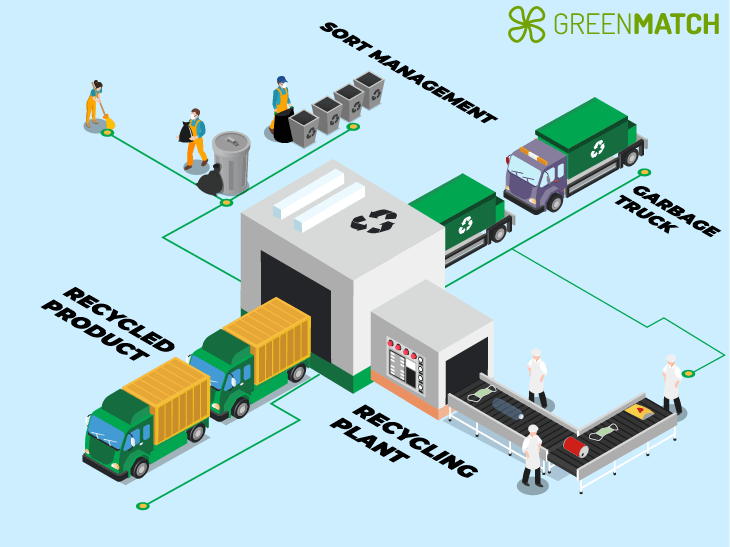
Challenges and limitations
Despite its benefits, it has challenges. The process consumes energy and resources, and not all materials are recycled at the same rate. For instance, paper and paperboard have higher rates, while plastics and glass lag.
One of the fundamental challenges is that not all materials can be recycled. Moreover, recyclable materials can only undergo the process a limited number of times before they degrade in quality, a phenomenon known as downcycling. This degradation limits the lifespan of materials within a loop and eventually necessitates using virgin materials to maintain product quality.
Another significant concern is the toxicity and environmental impact of recycled plastics. Plastics can contain various additives and chemicals that may harm human health and the environment. During the recycling process, these substances can be released into the environment or remain in the recycled products, posing risks to both.
Despite the widespread use of recycling bins, a staggering amount of plastic waste is in landfills or contaminates natural environments. A report by Greenpeace highlighted the grim reality that no plastic material meets the threshold to be considered "recyclable" under the standard that requires a rate of 30%.
This indicates a broader trend where the most plastic waste ends up in landfills or is incinerated, contributing to environmental pollution and greenhouse gas emissions.
Future directions
Recycling is good for the environment, offering substantial benefits regarding resource conservation, energy savings, and greenhouse gas emission reductions. This is a beacon of hope in our ongoing battle against waste and environmental degradation.
Yet, recycling rates are alarmingly low in many parts of the world, especially in low-income countries. For instance, China recycles just 30% of the plastic it produces, and in some regions, more than 90% of waste is dumped or burned, contributing to local pollution and the broader issue of climate change.
By 2050, waste production in low-income countries is expected to triple, underscoring the urgent need for innovative solutions and global cooperation in waste management and recycling efforts.
Despite these challenges, there is hope on the horizon. New technologies and practices are emerging to make this more efficient and accessible worldwide. For example, developing new recycling facilities, such as the one in Wisconsin that can produce 680,000 tonnes of paper from recycled waste paper annually, demonstrates the potential for significant advancements in capacity.
As we move forward, it's crucial that we not only focus on improving recycling practices but also prioritise reducing consumption and reusing materials to minimise waste at its source.
Frequently asked questions
Yes, recycling conserves energy and natural resources. For example, recycling one ton of office paper can save the energy equivalent of consuming 322 gallons of gasoline.
Yes, all recycling needs to be clean and dry. Items should be empty and rinsed clean of food debris before being recycled. This prevents contamination and ensures that the recycling process is efficient and effective.
The environmental impact of different materials varies, and the EPA encourages using a life cycle perspective to compare these impacts. Factors such as the energy saved through recycling and the resources conserved play a crucial role in determining the environmental friendliness of materials.
Items that should never be placed in recycling bins include garden hoses, sewing needles, bowling balls, food or food-soiled paper, propane tanks or cylinders, aerosol cans that aren’t empty, syringes, broken glass, and broken light bulbs. These items can contaminate the recycling stream and cause damage to recycling equipment.
Recycling saves energy by reducing the need to extract, transport, and process raw materials, which is often energy-intensive. Manufacturing products from recycled materials typically uses less energy than producing the same product from virgin materials. For instance, making aluminium cans from recycled aluminium consumes 95% less energy than raw bauxite.
Recycling is crucial because it helps conserve valuable natural resources like minerals, metals, and trees. It reduces the need for extracting and processing new resources, which can be energy and resource-intensive. Recycling also saves energy compared to producing new products from raw materials and diverts waste from landfills and incinerators, reducing the environmental impact of these disposal methods

Inemesit is a seasoned content writer with 9 years of experience in B2B and B2C. Her expertise in sustainability and green technologies guides readers towards eco-friendly choices, significantly contributing to the field of renewable energy and environmental sustainability.
We strive to connect our customers with the right product and supplier. Would you like to be part of GreenMatch?

- What do we mean by recycling exactly?
- The three Rs of waste management
- Key statistics and trends
- Food recycling statistics and facts
- Paper recycling statistics and facts
- Plastics recycling statistics and facts
- Glass recycling statistics and facts
- E-Waste recycling statistics and facts
- Aluminium recycling statistics and facts
- Textile recycling statistics and facts
- Metal recycling statistics and facts
- Which countries are the best at recycling?
- Environmental impact of recycling
- Challenges and limitations
- Future directions
- Frequently asked questions
